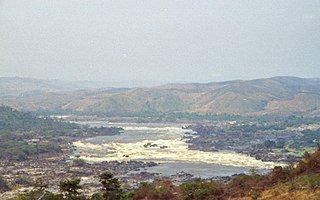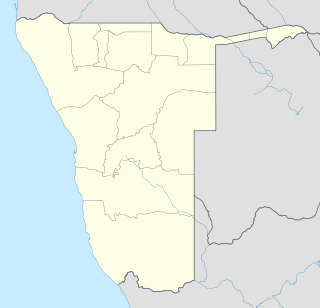Related Research Articles

Namibia follows a largely independent foreign policy, with strong affiliations with states that aided the independence struggle, including Libya and Cuba.

Southern Africa is the southernmost region of the African continent, variably defined by geography or geopolitics, and including several countries. The term southern Africa or Southern Africa, generally includes Angola, Botswana, Eswatini, Lesotho, Malawi, Mozambique, Namibia, South Africa, Zambia, and Zimbabwe, though Angola may be included in Central Africa and Malawi and Mozambique in East Africa. From a political perspective the region is said to be unipolar with South Africa as a first regional power.

The Inga–Shaba EHVDC Intertie is a 1,700 kilometres (1,100 mi)-long high-voltage direct current overhead electric power transmission line in the Democratic Republic of Congo, linking the Inga hydroelectric complex at the mouth of the Congo River to mineral fields in Shaba (Katanga). It was primarily constructed by Morrison-Knudsen International, an American engineering company, with the converter equipment supplied by ASEA. Construction was completed in 1982 and it cost US$900 million. The scheme was, for many years, the longest HVDC line in the world.

Inga Falls is a rapid 40 km from Matadi in the Democratic Republic of the Congo where the Congo River drops 96 m (315 ft) over the course of 15 km (9 mi).
The individual member states of the African Union (AU) coordinate foreign policy through this agency, in addition to conducting their own international relations on a state-by-state basis. The AU represents the interests of African peoples at large in intergovernmental organizations (IGO's); for instance, it is a permanent observer at the United Nations' General Assembly.

The Inga Dams are two hydroelectric dams connected to one of the largest waterfalls in the world, Inga Falls. They are located in the western Democratic Republic of the Congo and 140 miles southwest of Kinshasa.

The African banded barb, Angola barb, blue-barred barb or fire barb is a ray-finned fish species in the family Cyprinidae.

The following outline is provided as an overview of and topical guide to Angola:

Railway stations in Angola include:

Angola is located on the western Atlantic Coast of Central Africa between Namibia and the Republic of the Congo. It also is bordered by the Democratic Republic of the Congo and Zambia to the east. The country consists of a sparsely watered and somewhat sterile coastal plain extending inland for a distance varying from 50 to 160 km. Slightly inland and parallel to the coast is a belt of hills and mountains and behind those a large plateau. The total land size is 1,246,700 km2 (481,400 sq mi). It has an Exclusive Economic Zone of 518,433 km2 (200,168 sq mi).
The Democratic Republic of the Congo was a net energy exporter in 2008. Most energy was consumed domestically in 2008. According to the IEA statistics the energy export was in 2008 small and less than from the Republic of Congo. 2010 population figures were 3.8 million for the RC compared to CDR 67.8 Million.

Botswana–Namibia relations refers to the current and historical relationship between Botswana and Namibia. As of 2009, relations were considered friendly, with the two neighboring countries cooperating on economic development. Botswana gained independence from Britain in September 1966. Namibia gained independence from South Africa in 1990 following the Namibian War of Independence, and the two countries soon after established formal diplomatic relations. Botswana has a high commission in Windhoek. Namibia has a high commission in Gaborone.

The Ruacana Hydroelectric Power Station is a hydroelectric power plant near Ruacana in northwest Namibia, close to the Angolan border.

The Grand Inga Dam is a series of seven proposed hydroelectric power stations at the site of the Inga Falls, in the Democratic Republic of the Congo. If built as planned, the 40 GW project would be the largest power station in the world.
The Zambezi Watercourse Commission (ZAMCOM) is a water management organization established by member states of the Southern African Development Community (SADC) whose territory contains the Zambezi river basin.
Swimming at the 2019 African Games was held from 21 to 24 August 2019 in Casablanca, Morocco.
Karate at the 2019 African Games was held from 24 to 26 August 2019 in Rabat, Morocco.

The Zambezian region is a large biogeographical region in Africa. The Zambezian region includes woodlands, savannas, grasslands, and thickets, extending from east to west in a broad belt across the continent. The Zambezian region lies south of the rainforests of the Guineo-Congolian region. The Zambezian region is bounded by deserts and xeric shrublands on the southwest, the Highveld grasslands of South Africa to the south, and the subtropical Maputaland forests on the southeast.
References
- 1 2 "Westcor pulls out of Inga III power project". PanaPress. 2009-08-13. Retrieved 2010-10-23.
- 1 2 Njini, Felix (2010-10-15). "SADC in bid to revive Westcor". The Southern Times. Retrieved 2010-10-23.
- ↑ "Power utilities sign WESTCOR shareholders agreement". SARDC. 2005-10-04. Retrieved 2010-10-23.
- 1 2 Enslin, Samantha; Durban, Payne (2007-12-07). "Inga faces hydroelectric growing pains". Business Report & Independent Online. Retrieved 2009-03-17.
- ↑ "Power to the people". Mmegi. 2005-09-09. Retrieved 2009-03-17.
- ↑ Kagwanja, Peter (2008-04-11). "Africa: White Power, Black Power And Power Shortages". Daily Nation. Retrieved 2009-03-17.
- ↑ Mosinyi, Wanetsha (2008-04-21). "Botswana: Govt Still Committed to Inga Project". Mmegi. Retrieved 2009-03-17.